
Abandoned & Little-Known Airfields:
Southwestern Colorado
© 2002, © 2024 by Paul Freeman. Revised 8/20/24.
This site covers airfields in all 50 states: Click here for the site's main menu.
For a 7th year, the CO pages of this website are sponsored by the Colorado Pilots Association:
____________________________________________________
Please consider a financial contribution to support the continued growth & operation of this site.
Baca Grande Airfield (revised 11/9/23) - (Original) Durango Airport (revised 8/20/24) - Hanson Airfield / Breckenridge STOLport (revised 2/21/24)
Mesita Airfield (added 12/7/15) - Monte Vista Municipal Airport / Movie Manor Airport (revised 11/9/23) - Navajo Airport (revised 11/9/23)
Star Nelson Airport / Star Nelson Airport / Sky Island Ranch Airport (revised 5/13/19)
____________________________________________________
(Original) Durango Airport, Durango, CO
37.28, -107.87 (Southwest of Denver, CO)

The original Durango Airport, as depicted on the November 1936 Trinidad Sectional Chart.
Photo of the airport while in use has not been located.
The original airport for the town of Durango was located adjacent to the northeast side of the town.
The date of establishment of Durango Airport has not been determined.
The earliest depiction which has been located of Durango Airport was on the November 1936 Trinidad Sectional Chart.
A much larger Durango La Plata County Airport opened to the southeast in November 1946,
which would eventually replace the original Durango Airport.

The last aeronautical chart depiction which has been located of the original Durango Airport was on the October 1950 Trinidad Sectional Chart.
It depicted the original Durango Airport as having a 4,200' unpaved runway.
In 1956 Fort Lewis College moved to the site of the original Durango Airport.
The original Durango Airport was no longer depicted on the November 1960 Trinidad Sectional Chart.
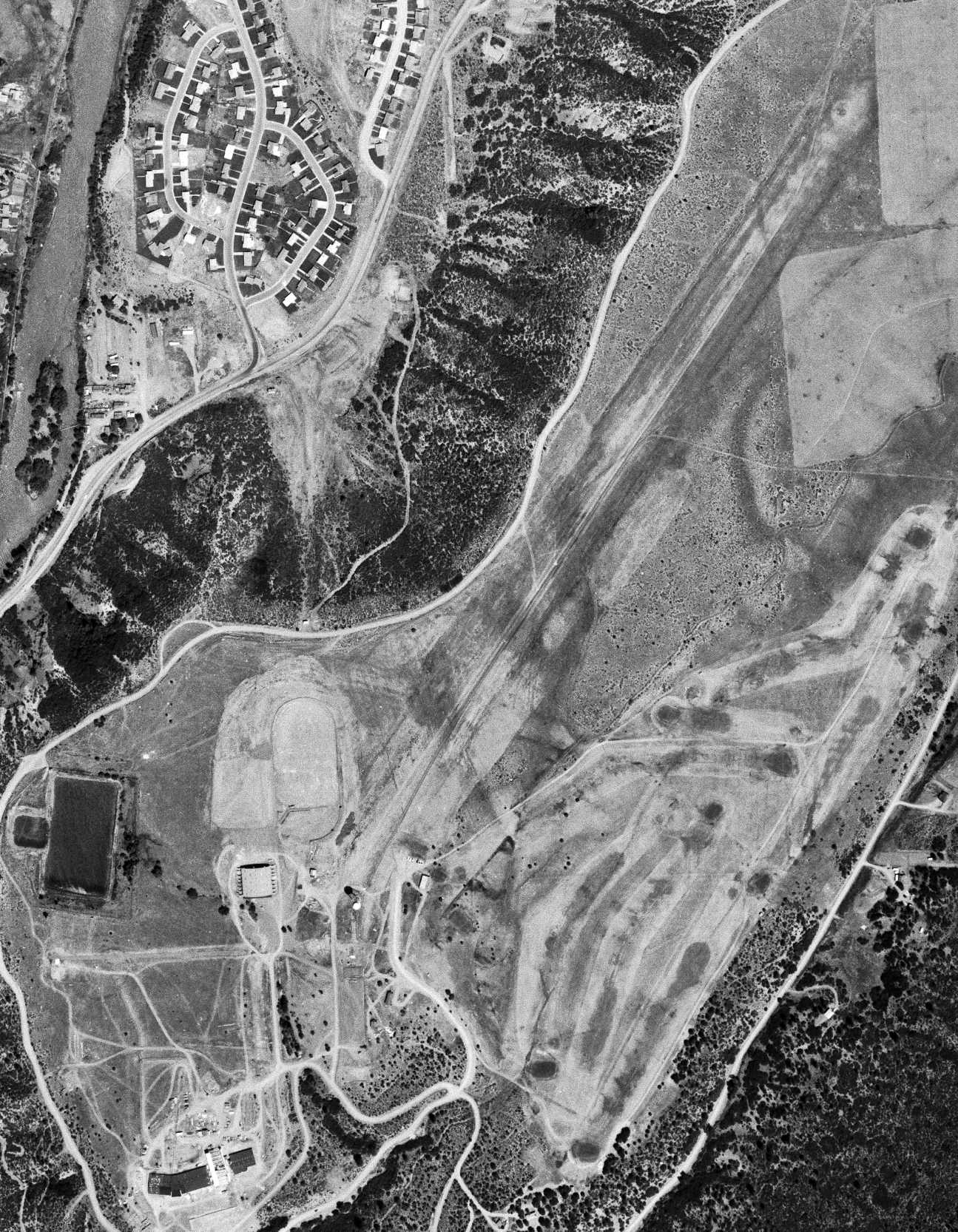
A 6/15/56 USGS aerial view showed the site of the original Durango Airport after its closure.
A northeast/southwest runway was still apparent, along with what appears to be a hangar at the southwest end of the runway.
A 1960 aerial view showed the majority of the site of the original Durango Airport covered by buildings of Fort Lewis College.
The northeastern runway portion was still recognizable, in an area which was redeveloped as Hillcrest Golf Club.
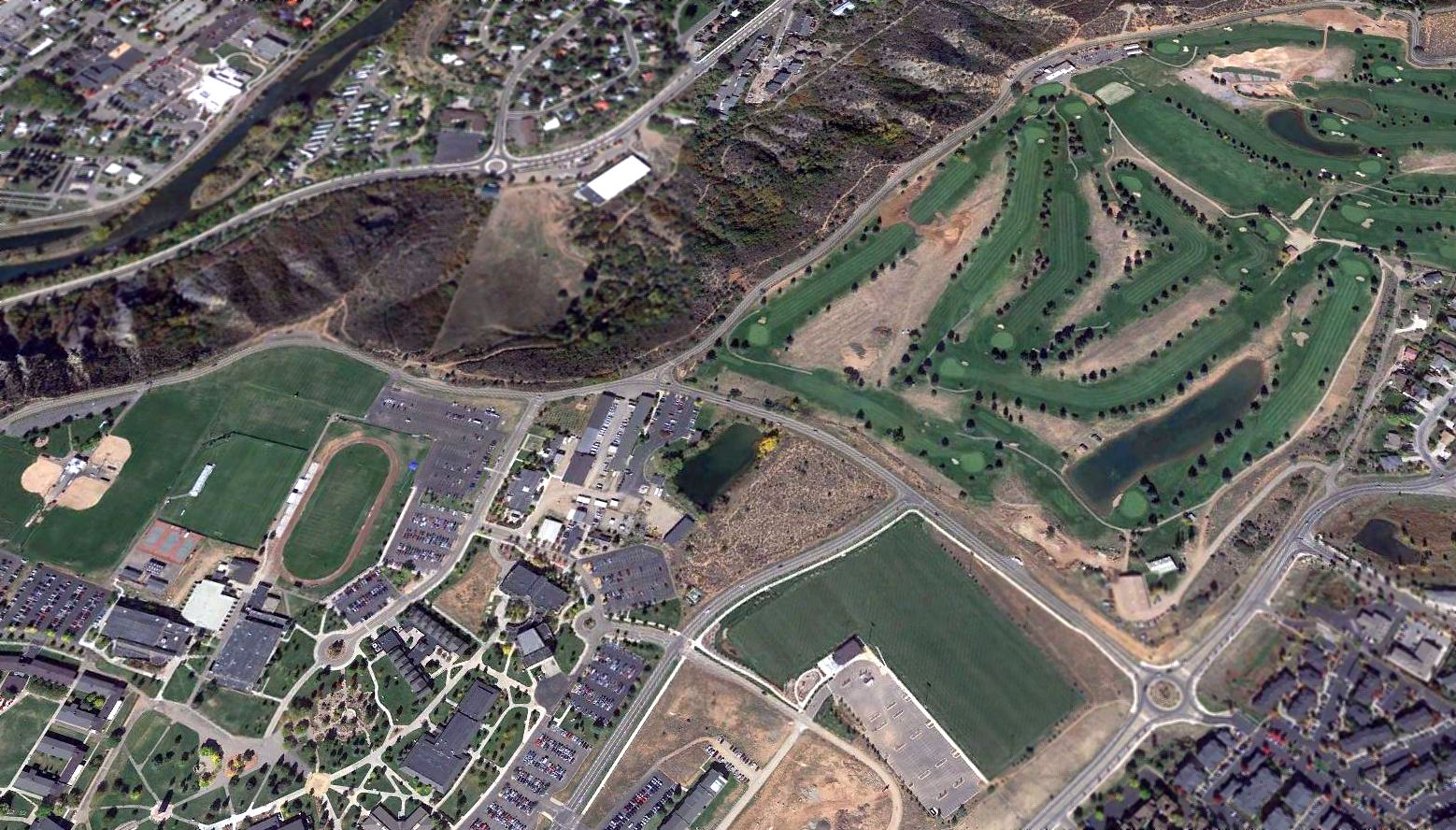
A 2015 aerial view looking northwest showed at the site of the original Durango Airport.
Eric Smith observed, “The old hangar on the southwest side of the airport [the white building to the left of the track] still exists & houses the campus Natatorium.”
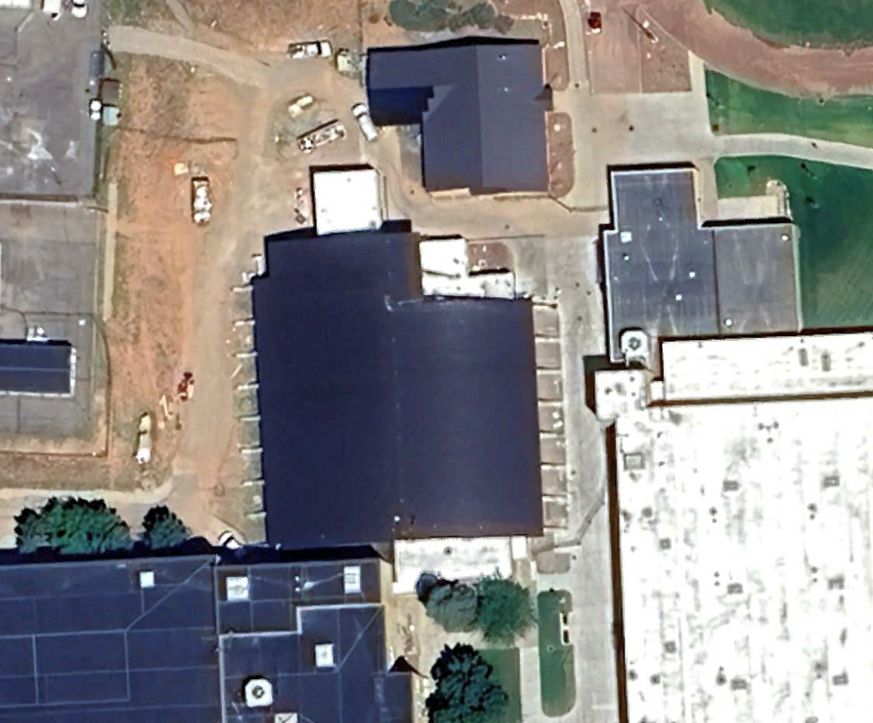
A 2024 aerial view of the former Durango Airport hangar, labeled by street maps as the Aquatic Center.
Thanks to Jeff Johnson for pointing out this airfield.
____________________________________________________
37.103, -105.537 (Southwest of Denver, CO)
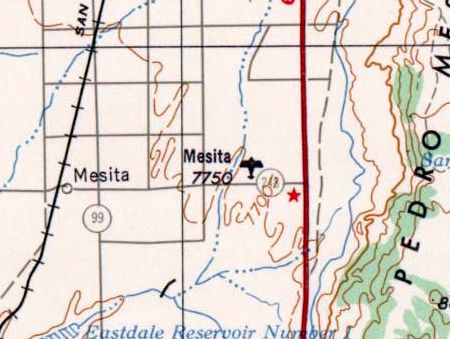
Mesita Airfield, as depicted on the 1958 USGS topo map.
Photo of the airfield while in use has not been located.
The date of establishment of this rural airfield has not been determined.
The earliest depiction which has been located of Mesita Airfield was a 1955 aerial photo, which depicted it as having 3 unpaved runways.
There did not appear to be any buildings or aircraft on the airfield.
The Mesita Airfield was not yet depicted on the 1955 USGS topo map.
The earliest depiction which is available of the Mesita Airfield was on the 1958 USGS topo map.
Mesita Airfield was not depicted on the November 1960 or March 1969 Trinidad Sectional Charts.

The 1983 USGS topo map depicted the Mesita Airfield as 3 runways, labeled simply as “Landing Strips”.

The earliest photo which has been located of Mesita Airfield was a 1999 USGS aerial view looking north, which depicted it as consisting of 3 unpaved runways.
There did not appear to be any buildings or aircraft on the airfield.
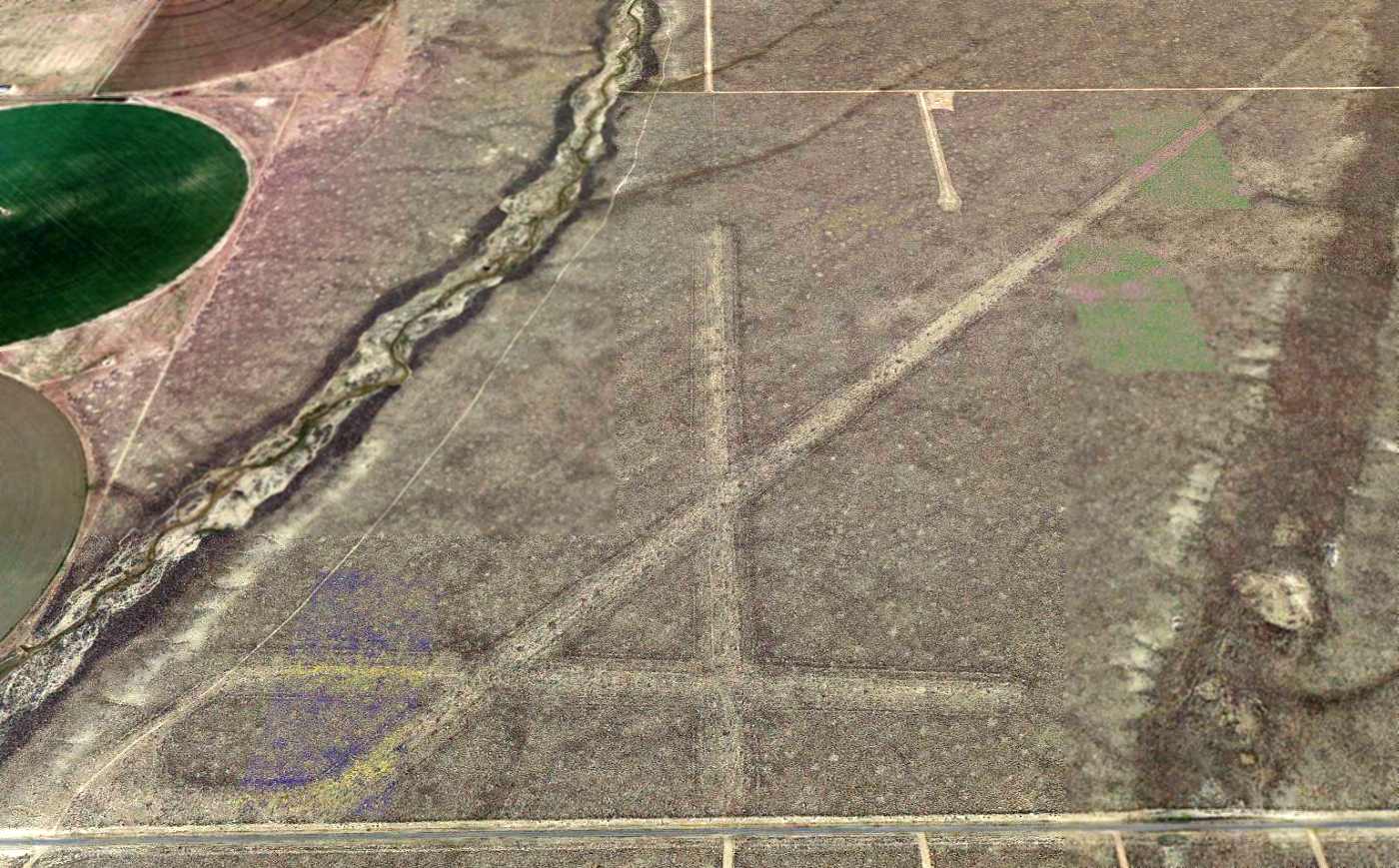
A 2013 aerial view looking north showed the Mesita Airfield remained intact, though without any sign of recent usage.
As of 2015, there was no airfield in Mesita registered with the FAA.
Mesita Airfield is located northwest of the intersection of Route 159 & Road H.
Thanks to Anthony Yon for pointing out this airfield.
____________________________________________________
37.004, -107.424 (Southwest of Denver, CO)
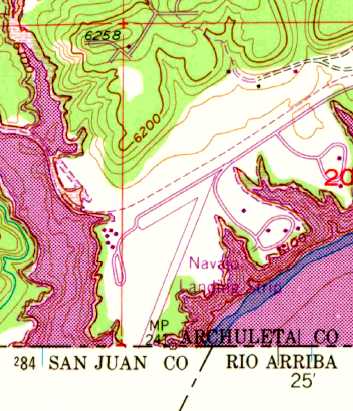
“Navajo Landing Strip”, as depicted on the 1971 USGS topo map.
Jonathan Westerling reported, “Here's a little airfield that's interesting for 2 reasons.
Firstly, its runway spans the border between 2 states.
Secondly, its closure garnered some attention with State Senators taking opposite sides.
Its not often that pilots can get attention from Washington to reopen an airport, but that's the case with little Navajo Airfield.
The airstrip was built to support the small community of Arboles, a few hundred residents on the border of Navajo State Park.
Visitors to the park comprised a majority of the landings at the airstrip, though there were a few local pilots in the town.
The airfield is also unique for its runway which straddles the Colorado / New Mexico state line, a fact which contributed to its demise.”
Navajo Airport was evidently constructed at some point between 1970-71,
as it was not yet depicted on the 1954 USGS topo map nor on the 1970 Denver Sectional Chart (according to Chris Kennedy).
The earliest depiction which has been located of Navajo Airport was on the 1971 USGS topo map,
which depicted “Navajo Landing Strip” as having a northeast/southwest runway, with a ramp on the northwest side.
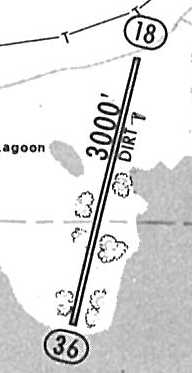
The 1972 New Mexico State Division of Aeronautics map (courtesy of Chris Kennedy)
depicted Navajo Airport as having a 3,000' northeast/southwest dirt runway.

The earliest aeronautical chart depiction which has been located of Navajo Airport
was on the 1974 Denver Sectional Chart (courtesy of Jonathan Westerling).
It depicted Navajo as a public-use airport having a 3,000' unpaved runway.
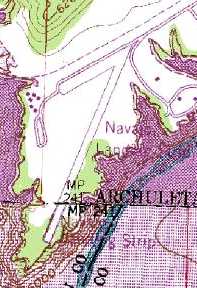
The 1975 USGS topo map depicted “Navajo Landing Strip” as having a single northeast/southwest runway,
with a ramp area at the northwest end.
The runway may have been slightly lengthened at some point between 1974-76,
as the 1979 AOPA Airports USA Directory(courtesy of Jonathan Westerling)described “Arboles” Airport
as a 3,600’ runway with an attendant, snack bar, and ballooning operations.
A 1986 FAA inspection(courtesy of the Colorado Department of Transportation)described “Navajo Landing Strip” as having a 3,150’ runway,
and said it was owned by the Bureau of Reclamation.
Notes about the airfield include a camping area & tiedowns at the north end.
It reportedly conducted 400 takeoffs or landings / year.

The earliest photo which has been located of Navajo Airport
was an undated aerial view looking southwest from the 1988 CO Airport Directory (courtesy of Jonathan Westerling).

The last aeronautical chart depiction which has been located of Navajo Airport was on the 1992 Denver Sectional Chart (courtesy of Jonathan Westerling).
It depicted Navajo as a public-use airport having a 3,100' unpaved runway.

The only photo which has been located showing aircraft at Navajo Airport
was a 9/4/93 USGS aerial view looking south, which showed 3 light single-engine aircraft parked on the north end of the field.
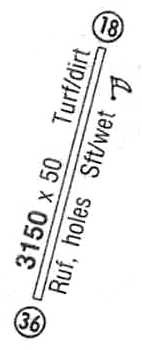
The 1994 Flight Guide (courtesy of Chris Kennedy) depicted Navajo as having a single 3,150' “turf/dirt” Runway 18/36, described as “Ruf, hold, Sft/wet”.
By 1995, the runway was resurveyed at 3,150'(according to the Colorado Airport Guide).
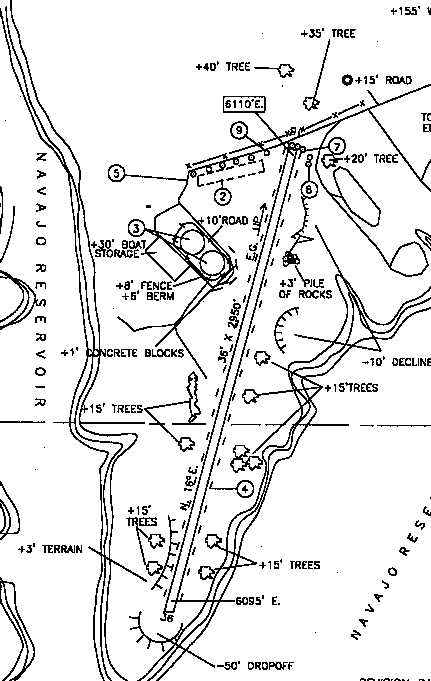
Jonathan Westerling reported, “Curiously, a 1999 FAA inspection report(courtesy of the CDOT)shows a hand-revised appraisal of the airfield.
The length of the runway was downsized to 2,950’ & the number of annual operations was revised from 340 down to 60.”
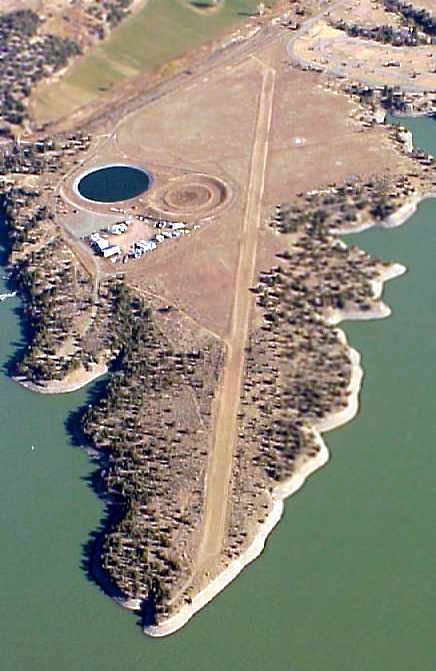
The last photo which has been located showing Navajo Airport while open was a 2000 CAP aerial view looking north (courtesy of Jonathan Westerling).
Jonathan Westerling reported, “The airfield's fate was doomed according to a 2001 letter to the CDOT
from State Senator Ben Nighthorse Campbell(courtesy of the CDOT Aeronautics division)”.
The letter read: “It has come to my attention that the Colorado Division of Parks & Outdoor Recreation
is planning to implement its earlier decision to close the dirt airstrip in Arboles, Colorado at Navajo State Park.
In the 1992 Parks Management Plan, the Division of Parks made it abundantly clear in public meetings
that land near the park would be needed for the improvement & construction of new facilities at some point in the near future.
The Park did allow the airstrip to remain open until the construction and improvements nearby were underway.
While I never like to see an airport or even a minor airstrip close,
I believe that the Division of Parks has taken appropriate steps in its gathering of information & public input in coming to this decision.
Public meetings on this topic were held nearly a decade ago.
And stakeholders who were permitted to offer their input were aware of & accepted the Decision at that time.
While the Division of Parks has allowed the strip to remain in service as a courtesy since then,
it is clear that the continued operation of this remote airstrip poses safety & liability concerns
created both by the need of additional space for park improvements,
and the clear refusal by the State of New Mexico to recognize one third of the airstrip located there for use.
This closure, while clearly not supported by the handful of people who stand to benefit from continued operation of the airstrip,
was not an arbitrary or capricious one on the part of the Division of Parks.”
Jonathan Westerling reported, “In spring of 2001, the airport was officially closed.
The 7/7/01 issue of the local paper [the Pagosa Sun] contained an editorial from a local pilot publicly announcing the closure.”
It read: “On 5/9/01 the airstrip at Arboles, Navajo State Park, was officially closed after 35 years of operation.
However, it is the belief of several that closing of the strip was unnecessary
and disposes of the park's unique ability to provide enjoyment to the outreaches of the state & beyond.
As well, the strip is an excellent base for emergency fire-fighting crews, search and rescue & a training facility for flight instructors.
This is the last public backcountry airstrip in Colorado.”
Jonathan Westerling reported, “In August of 2001, another article appeared in the local paper [the Pagosa Sun]
with additional detail surrounding the airports closure.”
It read: “According to some small-engine aircraft pilots, it is a one-of-a-kind piece of Colorado history that should be maintained for its original use - an airfield.
On the other hand, state management & construction plans outline a rebirth of the dirt field at Navajo State Park
for overflow parking & dry storage as a response to the increasing numbers of boaters & campers.
Right now [2001], the airstrip is closed & has been since mid-May,
about 9 years after the state parks board first voted to remove the airstrip as part of a 1992 management plan.
Currently, the park gets about 120,000 visitors per year, about 90,000 boaters and 30,000 campers, Park Manager John Weiss said.
In comparison, the number of planes landing on the airstrip dropped to 44 in 2000.
Rangers kept statistics on the airfield by counting planes visible on the field as they drove by during regular activities.
Safety & liability are other issues with the airfield that concern Weiss.
For instance, 1/3 of the strip is over the New Mexico state line, and officials from that state have refused to acknowledge an airstrip on their land, Weiss said.
The airstrip also falls short of Federal Aviation Administration standards on several counts.”
Jonathan Westerling reported, “However, according to the NTSB, there were exactly zero safety incidents at the Navajo airstrip in its last 22 years of operation.
Also, the airstrip appears on numerous airfield directories published by the State of New Mexico, so they obviously knew about the existence of the airfield.”
Jonathan Westerling reported, “A year after the airfield closed, Colorado's other Senator, Wayne Allard took an opposite stand.
In a September 2002 letter, he asked Interior Secretary Gale Norton for the swift consideration of reopening of the airstrip.
In his letter he questions the authority of the Colorado Park Service to close the airport in the first place.
It read: “The Park Service believed the airport was theirs to close,
but it turns out that the land belongs to the Bureau of Reclamation & thus could potentially be considered a backcountry landing strip.
Although there is support to reopen the airstrip, including support by the Colorado General Assembly
which enacted legislation to remove liability concerns about aircraft operations from state lands,
park management is adamant in its position to keep the airstrip closed.
Arboles has operated safely and without incident as a recreational airstrip since park management constructed it shortly after WW II.
The airstrip is in good condition & little, if any, investment would be required to reopen the facility.
I would like for you kindly to look into the situation & let me know the Department's position on possibly reopening this landing strip.”
Jonathan Westerling reported, “The Colorado Aeronautical Board sent a similar letter
encouraging the reopening of the airfield, but these efforts apparently were unfruitful.”
A 6/18/04 aerial view showed closed-runway “X” symbols on each end of the Navajo Airport runway,
and an asphalt parking area for trailers adjacent to the west edge of the runway.
Navajo Airport was no longer depicted on the 2004 Denver Sectional Chart (courtesy of Jonathan Westerling).
A 7/31/05 aerial view showed the Navajo Airport asphalt parking area had been extended over the middle portion of the former runway.
Jonathan Westerling reported, “A 2007 article published by AOPA revisited Arboles as a reason to support airport legislation pending in Congress.”
It read: “The Arboles Airstrip, like many backcountry landing strips, faces an uncertain future.
Navajo State Park & the airstrip straddle the Colorado/New Mexico state line,
blurring jurisdiction & affirming the need for a federal law like the Backcountry Landing Strip Access Act (H.R. 1363/S. 681).
If passed, the bill would nationally codify the process of airport closings & include local and state officials in those decisions.”
Jonathan Westerling reported, “However, the Act was never passed, and according to photos,
the Navajo Landing Strip sits in the same condition it was when it was closed in 2001.”

A 5/9/09 aerial view showed that closed-runway “X” symbols were still visible on both ends of the former Navajo Airport runway.
The site of Navajo Airport is located south of San Juan Marina Road.
____________________________________________________
Monte Vista Municipal Airport / Movie Manor Airport, Monte Vista, CO
37.58, -106.205 (Southwest of Denver, CO)
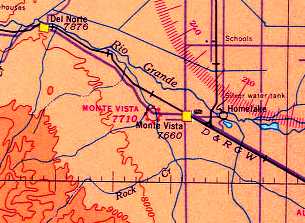
Monte Vista Airport, as depicted on the 1936 Trinidad Sectional Aeronautical Chart.
According to the 1973 “James G. Hamilton Post #53 American Legion History” (courtesy of Allen Heersink),
“In March 1928, the Post started their first work on the airport, located 2 miles west of Monte Vista.
The first airmail being carried to & from the San Lius Valley was through the efforts of the Legion Post.
Private planes, Monarch Airlines, and Frontier Airlines all used this airport.”
The earliest airport directory listing which has been located of the Monte Vista Airport
was its listing in the 1931 Department of Commerce Airfield Directory (courtesy of David Brooks via Chris Kennedy).
It described Monte Vista as a municipal airport, located 2.5 miles west of the town.
It was said to consist of a 600 acre gravel square, measuring a mile on each side,
within which were 3 runways, with the longest being a 5,500' northeast/southwest strip.
The February 1944 Trinidad Sectional Chart (courtesy of Chris Kennedy) depicted Monte Vista Airport as an auxiliary airfield.
The February 1954 Trinidad Sectional Chart (courtesy of Chris Kennedy) depicted Monte Vista Airport as having a 5,800' unpaved runway.
According to Richard Cutter, “Monarch Airlines operated DC-3s out of here.”
According to the 1973 “James G. Hamilton Post #53 American Legion History” (courtesy of Allen Heersink),
“Our old airport was sold on 4/19/55 to Fred Ryals by the City of Monte Vista.
Mr. Ryals then sold the land to Geoge Kelloff, who constructed the Movie Manor Movie & Motel.”

An 11/12/60 USGS aerial view depicted Monte Vista Airport as having 4 unpaved runways,
although a drive-in movie theater had been built over the northeast portion of 2 of the runways.
There were no aircraft or other signs of recent aviation usage.
The Monte Vista Airport was evidently closed by 1962,
as it was no longer depicted at all on the December 1962 Trinidad Sectional Chart(according to Chris Kennedy).
At some point between 1962-68, it was evidently reopened as Movie Manor Airport,
as that is how it was depicted on the February 1968 Trinidad Sectional Chart (courtesy of Chris Kennedy),
with a 5,000' unpaved runway.
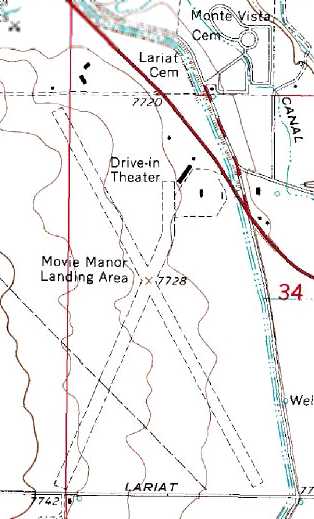
The 1964 USGS topo map depicted the “Movie Manor Landing Area” as having 2 unpaved runways,
with the northeastern end of one runway truncated by a drive-in movie theater.
It is unclear whether any of the small buildings nearby were related to the airfield.
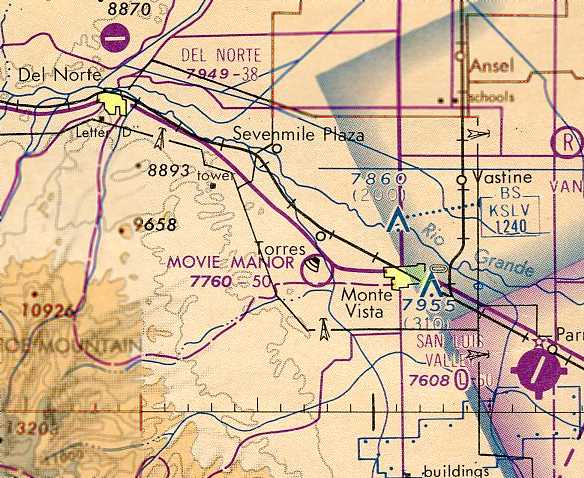
The February 1977 Denver Sectional Chart (courtesy of Chris Kennedy) depicted Movie Manor as a public-use airport having a 5,000' unpaved runway.
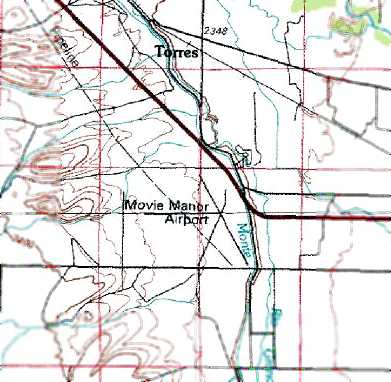
The 1979 USGS topo map depicted the “Movie Manor Airport” as having 2 unpaved runways.

The last aeronautical chart depiction which has been located of the Movie Manor Airport was on the 1986 Denver Sectional Chart (courtesy of Jonathan Westerling).
It depicted Movie Manor as a public-use airport having a 5,000' unpaved runway.
Movie Manor Airport was evidently closed (for reasons unknown) at some point between 1986-92,
as the 1992 Denver Sectional Chart (courtesy of Jonathan Westerling) only depicted the drive-in movie theater, but no longer its airfield.

A 1998 USGS aerial view looking north at Movie Manor Airport showed the remnants of the 4 runways,
but there were no signs of aircraft or other recent aviation usage.
Richard Cutter reported in 2009, “There is now a drive-in movie & motel (Best Western Movie Manor).
Runways are overgrown with brush & not usable but very visible from the air. All pavement is gone.”

A 103 aerial view looking north at the site of the Monte Vista Airport, showing the remains of the 4 runways.
It is not apparent whether any of the adjacent buildings date from the site's days as an airport.
The Monte Vista Airport is located southwest of the intersection of Route 160 & County Road 25.
Thanks to Richard Cutter for pointing out this airfield.
____________________________________________________
Baca Grande Airfield, Crestone, CO
37.96, -105.78 (Southwest of Denver, CO)
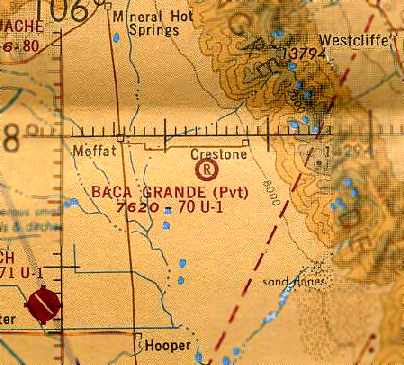
Baca Grande Airfield, as depicted on the July 1973 CG-19 World Aeronautical Chart (courtesy of Chris Kennedy).
This private airfield was evidently established at some point between 1968-73,
as it was not yet depicted on the 1967 USGS topo map nor on the 1968 Denver Sectional Chart (according to Chris Kennedy).
The earliest depiction of the Baca Grande Airfield which has been located
was on the July 1973 CG-19 World Aeronautical Chart (courtesy of Chris Kennedy).
It depicted Baca Grande as a private airfield having a 7,000' runway.
According to Elli Monk, the “Baca Grande runway... was established because the Aspen Institute was going to have a base there.”
The 1976 AOPA Airport Directory (according to Chris Kennedy) listed Baca Grande as a private airfield,
and indicated that the Baca Grande Inn (1 mile away) offered lodging.
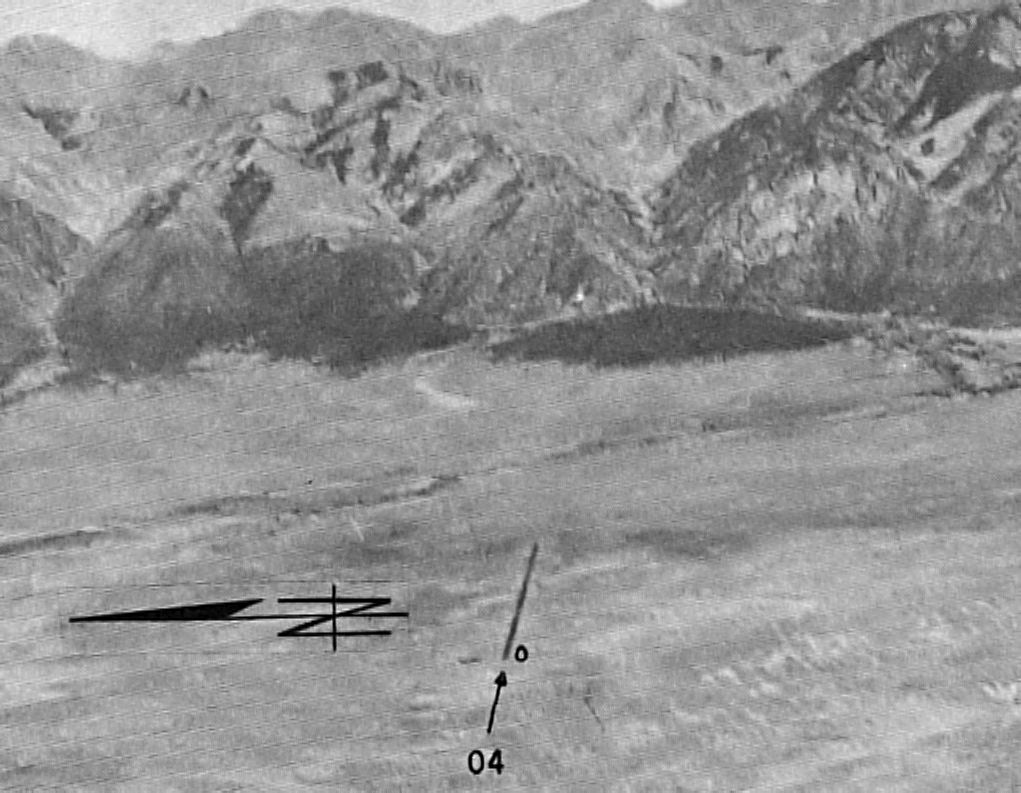
The earliest photo which has been located of Baca Grande Airfield was an undated aerial view looking east from the 1976 CO Airport Directory (courtesy of Alex Hauzer).
The directory described Baca Grande as a private airfield with a single 7,000' paved Runway 4/22.
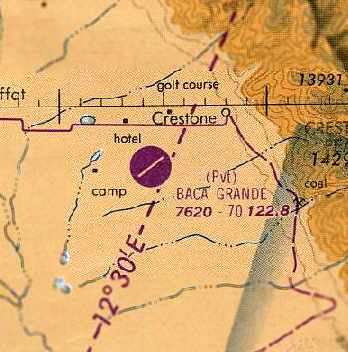
The February 1977 Denver Sectional Chart (courtesy of Chris Kennedy)
depicted Baca Grande as a private airfield with a single 7,000' paved northeast/southwest runway.
Baca Grande was still listed as an active airfield in the 1982 AOPA Airport Directory(according to Chris Kennedy).
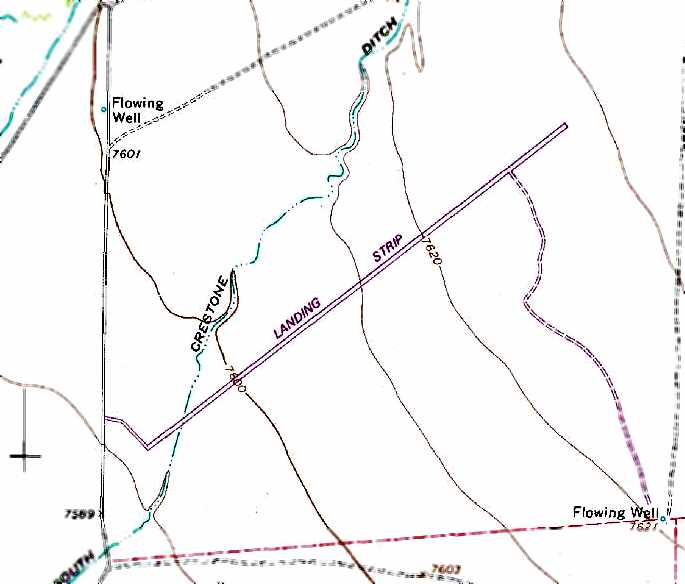
The 1982 USGS topo map depicted the single runway, labeled merely as “Landing Strip”.
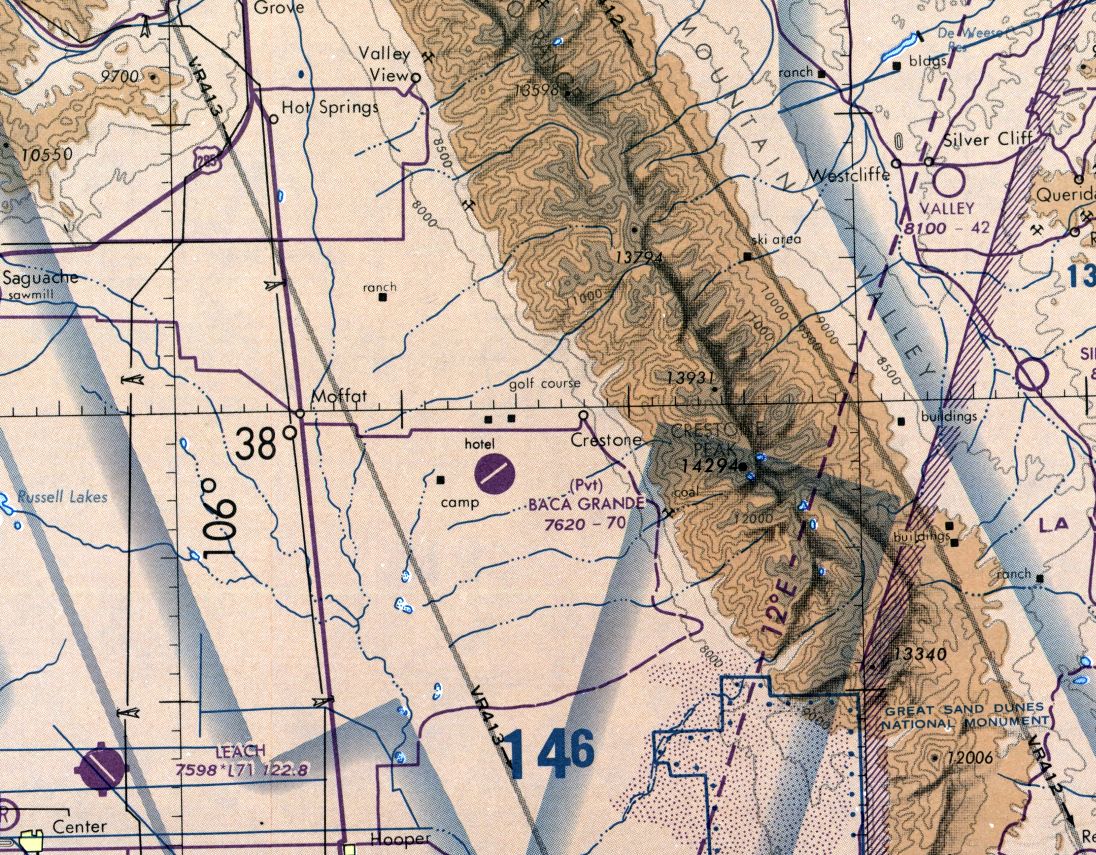
The last aeronautical chart depiction which has been located of Baca Grande Airfield was on the 1986 Denver Sectional Chart (courtesy of Jonathan Westerling).
It depicted Baca Grande as a private airfield with a single 7,000' paved northeast/southwest runway.
Baca Grande Airfield was evidently abandoned (for reasons unknown) at some point between 1986-92,
as it was depicted as an abandoned airfield on the 1992 Denver Sectional Chart (courtesy of Jonathan Westerling).

A 1999 USGS aerial view looking north showed that the single paved runway at Baca Grande remained in fine shape.
A paved parking pad was located at the southwest end, but there did not appear to be any buildings (or remains of buildings) at the site.
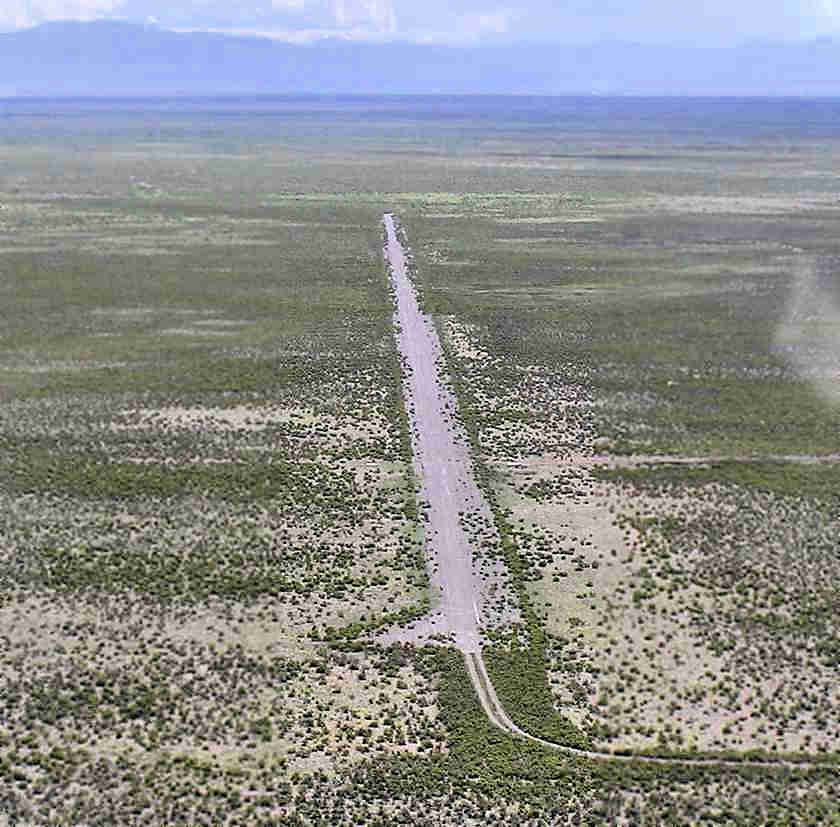
A 2004 aerial view by Andy Young looking southwest along the abandoned runway at Baca Grande.
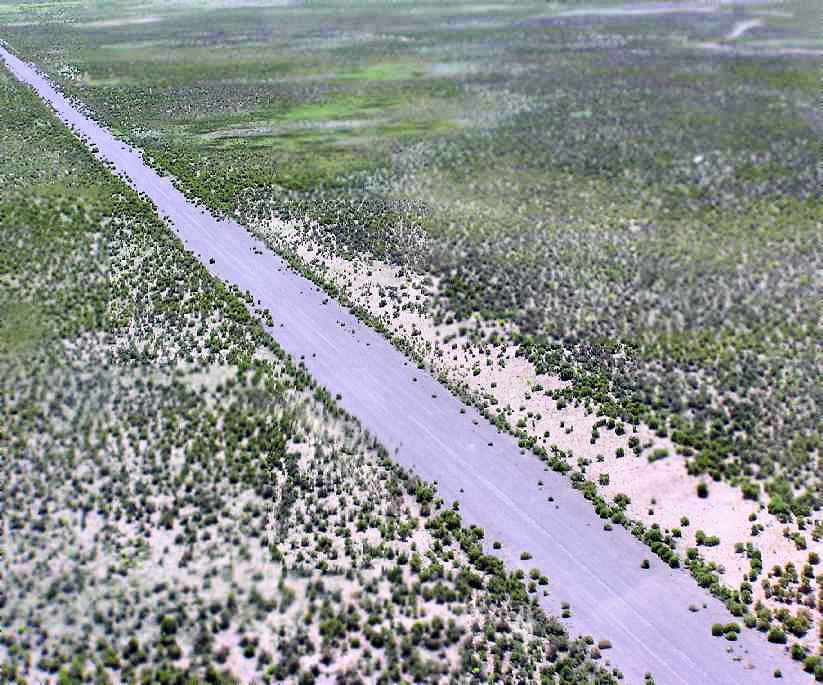
A 2004 aerial view by Andy Young of the pavement of the abandoned runway at Baca Grande.

A 2013 aerial view looking north showed that the single paved runway at Baca Grande remained intact.
The Baca Grande Airfield is located on the east side of Route 66T, 3 miles southwest of Crestone.
____________________________________________________
Hanson Airfield / Breckenridge STOLport, Breckenridge, CO
39.51, -106.05 (West-Southwest of Denver, CO)
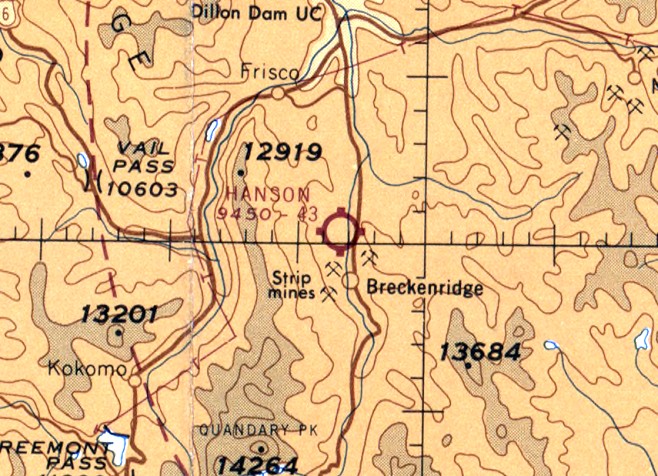
"Hanson" Airfield, as depicted on the June 1963 Denver Sectional Chart.
This short takeoff & landing airport was apparently established at some point between 1960-63,
as it was not yet depicted on the June 1960 Denver Sectional Chart.
The earliest depiction of an airfield at this location which has been located was on the June 1963 Denver Sectional Chart,
which depicted "Hanson" as having a 4,300' unpaved runway.
According to the article “Breckenridge's Airport Legacy” (courtesy of Jonathan Westerling),
“Rounds & Porter commissioned a runway on old dredge placer ground in the Breckenridge valley floor.
Extending from today’s Upper Blue Elementary School northward to Colorado Mountain College, the bumpy, dirt landing strip served private pilots & the Rounds family for many years.
Breckenridge’s fortunes changed in the early 1960s when Ralph Rounds died.
By the late 1960s, private pilots frequently took advantage of the Breckenridge air strip.
Long-time resident Jim Beck shared stories of flying into Breckenridge in his Oral History recording.”
Hanson Airfield apparently lasted no more than 5 years, as it was no longer depicted on the June & December 1968 Denver Sectional Charts.
A 1968 USGS aerial photo depicted possibly only a very rough unpaved runway.

Hanson Airfield reappeared on the 1970 Denver Sectional Chart (courtesy of Vince Granato),
depicted as a private airfield with a 4,000' unpaved runway.

The 1970 USGS topo map depicted Breckenridge Airport as having a single northeast/southwest unpaved runway.
According to the article “Breckenridge's Airport Legacy” (courtesy of Jonathan Westerling),
“The Breckenridge landing strip would soon play another pivotal role in Breckenridge’s ski town development.
Aspen’s purchase of the Breckenridge Ski Corporation in 1970 is well familiar today. But it almost didn’t happen.
In 1969, the Breckenridge Ski Area was quietly up for sale. Rounds & Porter, under the direction of Doc Rounds, wanted to focus on real estate, not ski area operations.
Aspen Ski Corp’s 'Darcy' Brown heard that an investor group from Chicago pursued Breckenridge acquisition.
According to Win Lockwood, eventual airport proponent, Brown needed to beat the Chicago people to Breckenridge to finalize Aspen’s purchase.”
Said Lockwood: “DRC got in his twin-engine plane in Aspen, asked Jim Nicholls to plow the Breckenridge airstrip, which was bordered by 4-story tall rock piles.
Somehow Jim got it plowed, DRC lands & leaves the plane on the runway. But no one picked him up.
So he hiked in his cowboy boots over snow to Highway 9, thumbed a ride to the base of Peak 8. He arrived with a $100,000 cashier’s check & signed the purchase contract.
An hour later, the black limousine arrives from the Denver airport with the Chicago guys. They weren’t happy.”
Previous Breckenridge resident Douglas Barr reported that "the Breckenridge Airport was in operation in 1971.
There was a runway and a fuel tank (on stilts)."

The 10/1/74 USGS aerial view depicted Breckenridge Airport as having a single northeast/southwest unpaved runway.
According to the article “Breckenridge's Airport Legacy” (courtesy of Jonathan Westerling),
“By 1976, the community was having serious conversations about developing a true airport.
In January of that year, the Summit County Journal shared a headline: 'Summit International Airport?'
A group of airport developers from Colorado Springs lobbied the community for charter & private flights, requesting an extension of the runway, paving & maintenance.
By April, the conversation turned to a commercial airport requiring FAA approval, a control tower & additional amenities.
Immediately, questions of safety came up. An article in the Summit Sentinel stated: 'The site itself has its own assets & liabilities.
The runway can be lengthened to about 8,000', which is long enough to handle most types of aircraft, but hilly terrain makes a ‘dogleg’ approach to the runway necessary.'”
People who did fly in & out of the Breckenridge air strip described it as 'a little hairy' & 'it was near death-defying when a crosswind was blowing out of Coyne Gulch.'”
The ski business was booming in the late-1970s, with growing competition from long-established ski areas like Aspen, and up-starts like Copper Mountain & Keystone.
And while the ski business was humming, summers were very quiet. To grab a greater share of the year-round tourism market, many of Breckenridge’s movers-&-shakers felt that a commercial airport was necessary.
The late 1970s through the early 1980s saw increasing momentum for an airport, along with growing opposition.
The next few years would see turmoil in Breckenridge around the airport & the growth it would bring.”
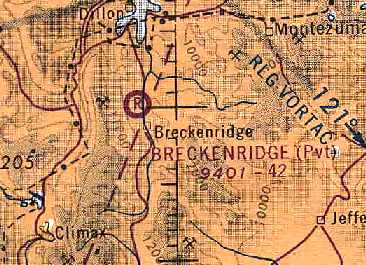
The August 1977 CG-19 World Aeronautical Chart (courtesy of Chris Kennedy)
depicted "Breckenridge" as a private airfield with a 4,200' unpaved runway.
According to the article “Breckenridge's Airport Legacy” (courtesy of Jonathan Westerling),
“By the late 1970s, talk of a commercial airport in Breckenridge buzzed around town.
A headline in the Summit County Journal in January 1976 asked: 'Summit International Airport?'
After initial intentions to develop an airport for private & charter flights, the conversation soon shifted to a full-service airport with regularly-scheduled passenger aircraft.
Breckenridge Lands, Inc, the successor entity to the Rounds’ family business ventures, wanted to donate the land for the airport development.”
John Rahm, then head of the Breckenridge Ski Corporation, supported the effort, saying “There will be an airport in Summit County, in the future.”
By spring, the Town appointed an airport study group comprised of Win Lockwood, Jeff Paffrath, Jerry Cooney, and Bob Maynard, CEO of Keystone.
Spring is also election season for Breckenridge Town Council and the “Bullish on Breckenridge” candidates, a pro-airport and pro-development slate, prevailed in the polls.
The study group kept their work quiet for several years until local residents were surprised in November 1978 with the headline: “Commercial Air Service Set to Begin in November 1979.”
This time, Summit County Government took the lead, reaching a tentative agreement with Rocky Mountain Airways
and the Breckenridge Economic Development Commission to construct & maintain a STOLport (Short Take-Off & Landing).
DeHaviland Twin Otters holding 19 passengers & Dash-7s carrying up to 49 passengers would be the aircraft of choice.
The agreement covered construction & paving of an 8,000’ runway, maintenance, a microwave landing system, runway lights, terminal building & ground transportation.
To meet FAA requirements for aviation, a 261’ tall tower would be erected.
Anticipating opposition, Win Lockwood of the BEDC said that the DeHaviland STOLcrafts were “among the safest planes today.”
Within a few years after completion, Lockwood anticipated that the airport would see 10 flights a day utilizing the Twin Otters, and during peak ski season, 20 flights a day with the Dash-7s.
Lockwood & other proponents of the airport touted it as an economic benefit.
The group’s summary stated: “Establishment of airline service will serve to make Summit County more competitive with other resort areas & will attract more influential visitors to the area.”
Within weeks, the opposition organized. Surprised by the sudden announcement of a coming airport, a group calling themselves CARE (Committee for Airport Review & Evaluation)
raised concerns about noise, impacts on neighborhoods near the STOLport, additional burdens on the Rescue Group for downed aircraft, and impacts from uncontrolled growth.
They also questioned the validity & need for air service.
Then-County Commissioner Scott Gould was in favor of the airport & pushed for its development.
As a private citizen, he worked on the feasibility study. When over 800 people signed a petition asking that the airport be put to public vote, the County Commissioners slowly backed away.
In April of 1979, the County first announced it would not pursue the citizens’ vote.
Then in February 1980, the BOCC voted 2-1 to return the land to BLI with hopes that Breckenridge would develop the airport, saying: “public sentiment was such that the County could not spend any of its funds on the airport.”
BLI had no interest in developing an airport either, so they donated the property to Breckenridge Christian Ministries, who in turn sold it to Lockwood’s group, Sawmill Station Associates.
Lockwood promised the airport would be operational by the arrival of winter 1981.
Sawmill Station Associates also ended the tradition of allowing private aircraft to use the Breckenridge landing strip, posting a notice:
“No aircraft is permitted to take off or land without express written consent of the owners, S&C Partners.”
The “S” being the Sawmill Station Associates and the “C” belonging to Cal-Colorado, an investment group headed by Nick Marsch, who then owned Breckenridge’s Bell Tower Mall.
S&C Partners worked through 1980 lining up Rocky Mountain Airways, permits & dollars.
The Town expected to see a request for annexation in October 1980, even though Ken Adams, Community Development Director was skeptical: “I question how many people will use it, especially being this close to Denver.”
The CARE group continued to raise concerns about the airline path directly over town, safety, fire, weather, noise & environmental issues.
A noise study conducted in the valley in November 1980 concluded that a Cessna landing created 70 decibels & a Dash-7 made 71 decibels of noise, less than truck traffic on Highway 9 which came in at 72-74 decibels.
As summer 1981 stirred, Win Lockwood published an editorial in the Summit County Journal praising the benefits of the coming airport & the positive financial & economic impact.
Emphasizing summer tourism, he said the airport would “balance the year-round economy & improve convention business.”
The airport proponents won by garnering 22 more “no” votes than those who voted “yes” in favor of prohibiting fixed-wing aircraft.
In 1982, interest rates soared. Investment cash was harder to come by. Aspen Ski Corporation pulled their financial support.
Rocky Mountain Airways’ spotty safety record, compounded with money woes, made Breckenridge a less attractive destination.
“Airport Grounded Indefinitely” the Summit County Journal headlined in January 1983.
The paper reported that negotiations between the town & the developer “broke off on a sour note.”
Lockwood claimed “the town has not been negotiating with Sawmill for the last 9 months in good faith.”
A month later, Sawmill Associated officially bowed out of the airport. The headline stated: “Developer to Wash Hands of Project.”
An airstrip continued in the valley floor for many years after. Battles over condemnation and value of the land carried on for decades.
It was listed as "Summit County (Breckenridge STOLport)" in the 1982 AOPA Airport Directory (courtesy of Ed Drury).
It was described as having a single 5,200' dirt & gravel Runway 16/34,
and it included the remark, "Caution: Private. Closed to public."
Even though the runway at Breckenridge was 5,200' long,
it was still considered a "short takeoff & landing" facility, due to its extremely high elevation: 9,401 feet above sea level!
It must have ranked among the highest airports in the US.
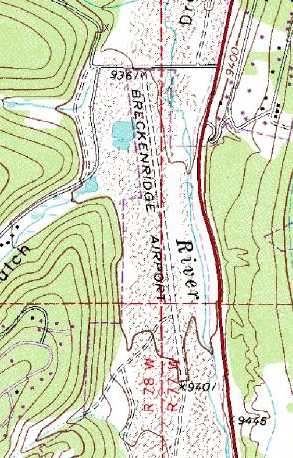
The 1987 USGS topo map still depicted the Breckenridge Airport as having a single north/south runway.
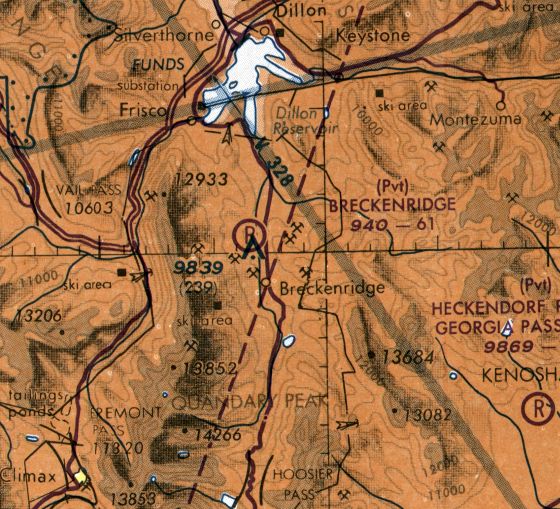
The 1992 Denver Sectional Chart (courtesy of Jonathan Westerling) depicted Breckenridge as a private airfield with a 6,100' unpaved runway.
It was still depicted as "Breckenridge (Pvt)" on the 1998 World Aeronautical Chart, by which point the runway had been lengthened to 6,100'.

As it existed in the 2001 USGS aerial photo, the airfield consisted of a single 4,600' runway.
It is not known if any of the surrounding buildings were related to the airfield.
The Breckenridge STOLport was evidently closed at some point between 1998-2002,
as it was no longer listed in FAA records as an active airfield as of 2002,
and it was no longer depicted at all (not even as an abandoned airfield) on 2002 aeronautical charts.
A 5/25/05 Summit Daily article entitled “Air travel returns to Breckenridge” reported:
An airplane parked on the old dirt runway north of town caught the eye of Breckenridge resident Greg Wright Saturday morning as he drove down Highway 9.
The single-engine Cessna was parked on the site that parallels Airport Road north of town.
Tied down & sitting quietly in the blustery storm, Wright realized it may have been the first time the dirt strip was used for its intended purpose in more than 20 years.
“According to the story I heard from one of the bystanders, the last guy who landed there had to take his plane apart & truck it out,” Wright said.
Wright returned Monday to see the aircraft take off & disappear into the sky.
According to a police report, a man from OR landed the plane on the old airstrip on Friday afternoon.
The pilot told a sheriff’s deputy that he was attempting to fly over the mountains but was forced to land due to an approaching storm.
The pilot, who had been traveling with his wife, stayed in Frisco, then took a taxi back to the aircraft Monday when the weather cleared.
“He had trouble starting the aircraft in the cold weather this morning, but finally got it started & made a normal takeoff” said Charles Toups, a driver with Summit Taxi who shuttled the pilot to his plane Monday morning.
Toups said the pilot seemed confident in his ability to depart, since he had a half-tank of gas instead of a full fuel load, which would reduce weight & boost airplane performance.
”He did kick up some dirt on his way out,” Toups said. “I was relieved to see he made a normal takeoff & departure.”
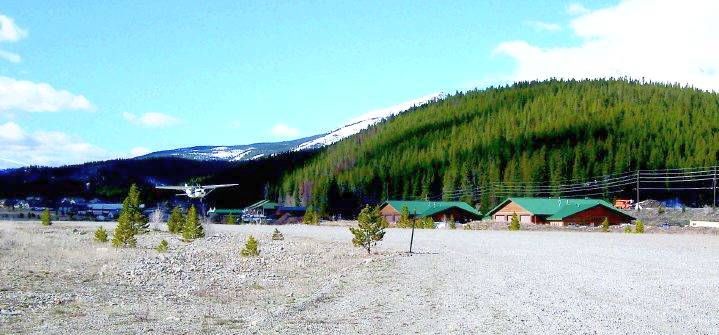
A 2005 photo of the last plane to take off from Breckenridge STOLport, a Cessna which had made a precautionary landing due to bad weather.
A 2007 aerial view showed the Breckenridge runway remained intact.
A 2010 aerial view showed several parking lots had been built over the northern portion of the Breckenridge runway at some point between 2007-2010.
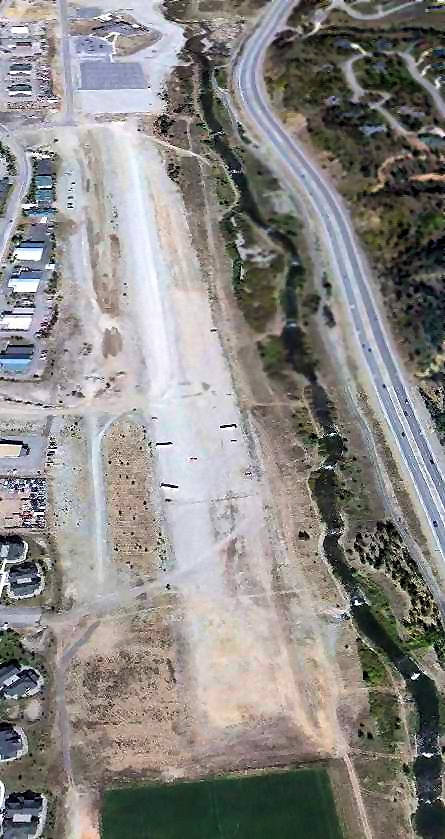
A 9/24/11 aerial view looking north showed a majority of the Breckenridge runway remained intact.
Holmes Gwin reported in 2013, “Breckenridge STOLport is currently used as free parking for skiers using the Breckenridge ski area.
The only remaining aeronautical artifact is the remains off an aircraft used by one of the businesses in the area.”
Brekenridge STOLport is located in between Route 9 & Airport Road, south of Coyne Valley Road.
____________________________________________________
Star Nelson Airport / Sky Island Ranch Airport (3CO0), Delta, CO
38.74, -108 (West-Southwest of Denver, CO)
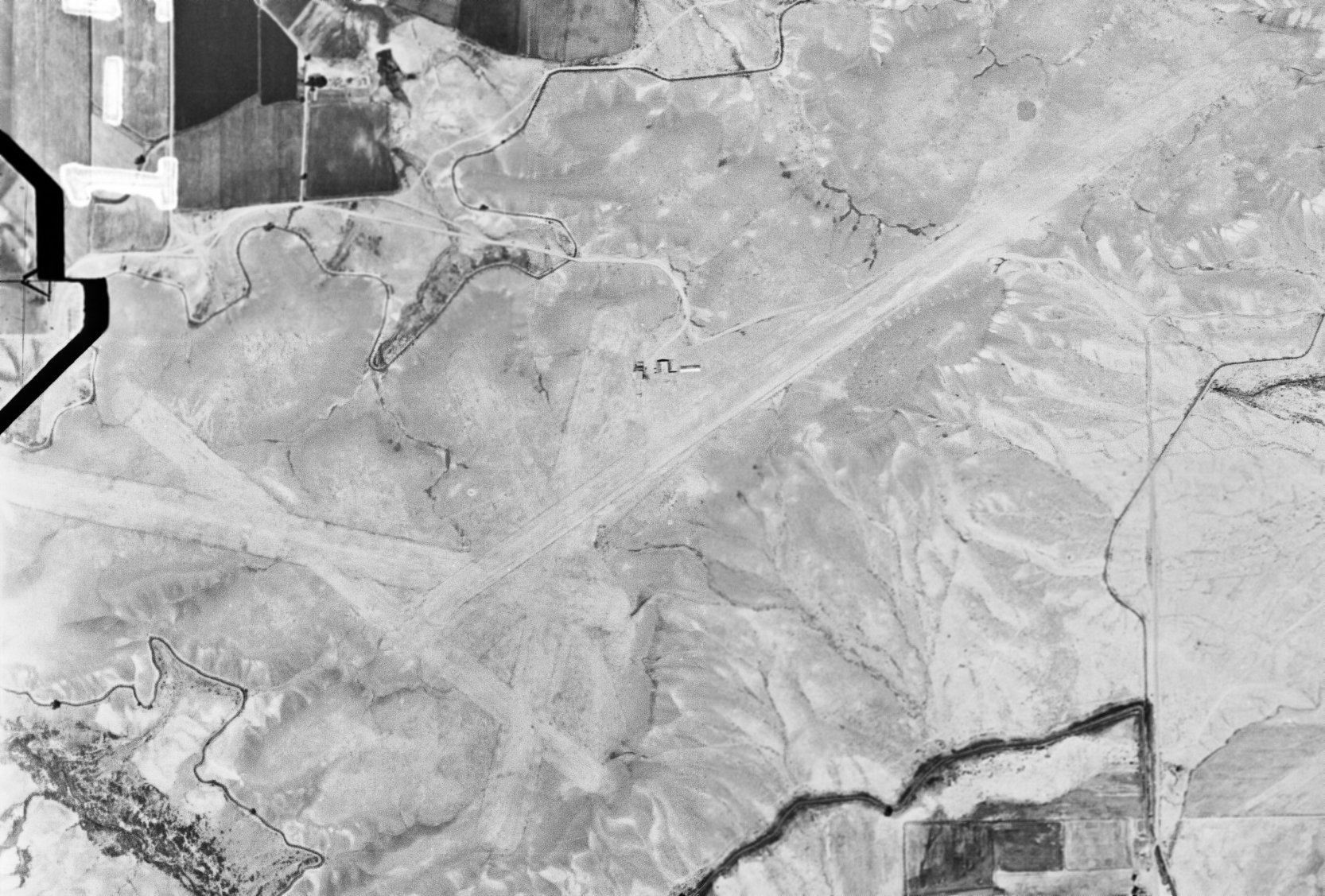
An 8/1/50 USGS aerial view of Star Nelson Airport.
This airport was located on top of a small mesa, three miles east of the town of Delta, CO.
The date of construction of this field is unknown.
The earliest reference to the field which has been located was on the Airport Directory Company's 1933 Airport Directory (courtesy of Chris Kennedy).
It described Delta as a municipal airport located 3.5 miles east of the town,
with three "sandy loam" runways (with the longest being the 3,600' east/west strip).
The 1934 Department of Commerce Airport Directory (according to Chris Kennedy) described Delta airport as having 3 sandy loam runways oriented in a "V",
with the longest being a 3,600' east/west strip.
The Airport Directory Company's 1937 Airports Directory (courtesy of Bob Rambo) described Delta Airport as having 3 "sandy loam" runways,
with the longest being a 3,600' east/west strip.
A hangar was described as having "Delta Airport" painted on the roof.
Delta Airport was described by the 1944 US Army/Navy Directory of Airfields (courtesy of Ken Mercer) as having a 3,800' runway.
According to Jon Gravestock, “I believe it [Star Nelson Airport] was used as a pilot training facility in the 1940s.”
Star Nelson was depicted on the 1949 Denver Sectional Chart (according to Chris Kennedy) as having a 5,600' unpaved runway.
Becca Davidson reported, “Star Nelson was my father's grandmother's brother.
My father told me that Star Nelson had his first flight in his 70s, but that it didn't go well: he 'crashed' the plane.
The airport apparently took away his privilege to use that site, but he bought the land.
I remember my father saying that Star Nelson was one of the oldest pilots in the U.S. in his time.”
The earliest depiction which has been located of Star Nelson Airport was an 8/1/50 USGS aerial view.
It depicted the field as having 3 unpaved runways, with a cluster of small buildings (hangars?) northeast of the runway intersection.
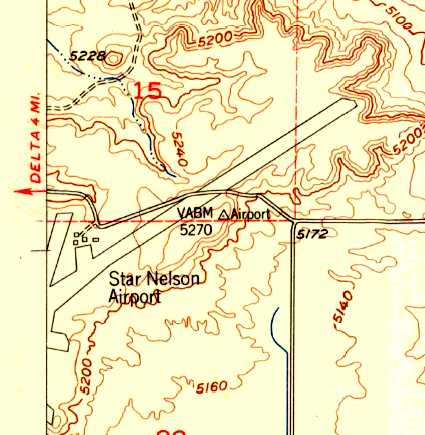
The 1955 USGS topo map depicted Star Nelson Airport as having 3 runways, with a cluster of small buildings northeast of the runway intersection.
Oddly, the longest runway was bisected by a road on the northeast side of the airport.
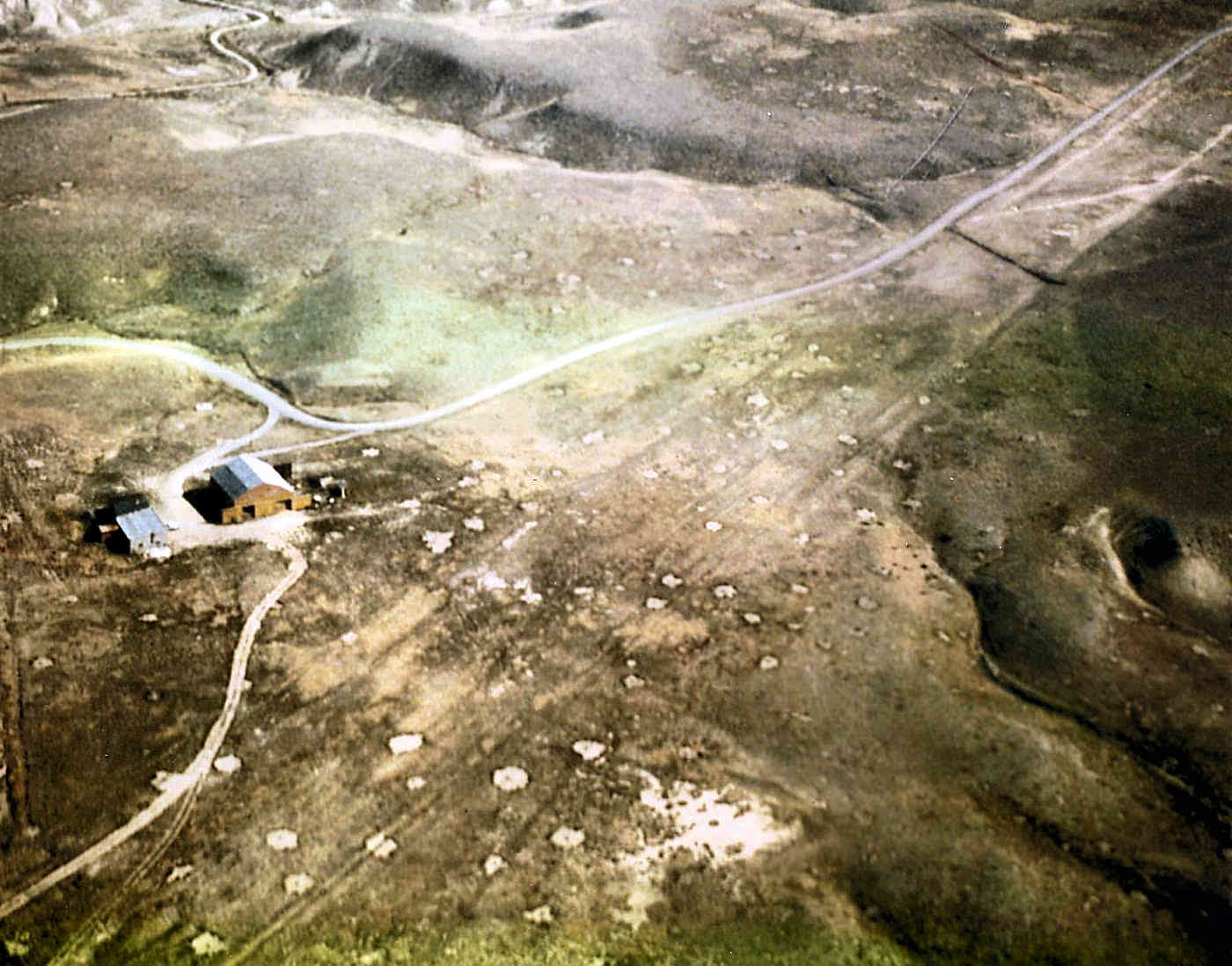
A circa late 1950s / 1960s aerial view looking north at Star Nelson Airport (courtesy of Jon Gravestock).
The 1962 AOPA Airport Directory described "Starr Nelson" Airport as having 3 gravel runways: 5,900' Runway 4/22, 3,700' Runway 9/27, and 3,200' Runway 18/36.
The operator was listed as G.H. Carmichael.
Star Nelson Airport was apparently replaced at some point between 1962-67 by Blake Field, 5 miles northwest.
Star Nelson was no longer depicted on the December 1967 Denver Sectional Chart (according to Chris Kennedy).
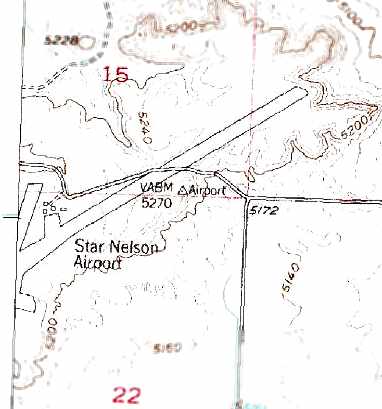
"Star Nelson Airport" was still depicted on the 1982 USGS topo map, even though it had apparently been closed for about 2 decades by that point.
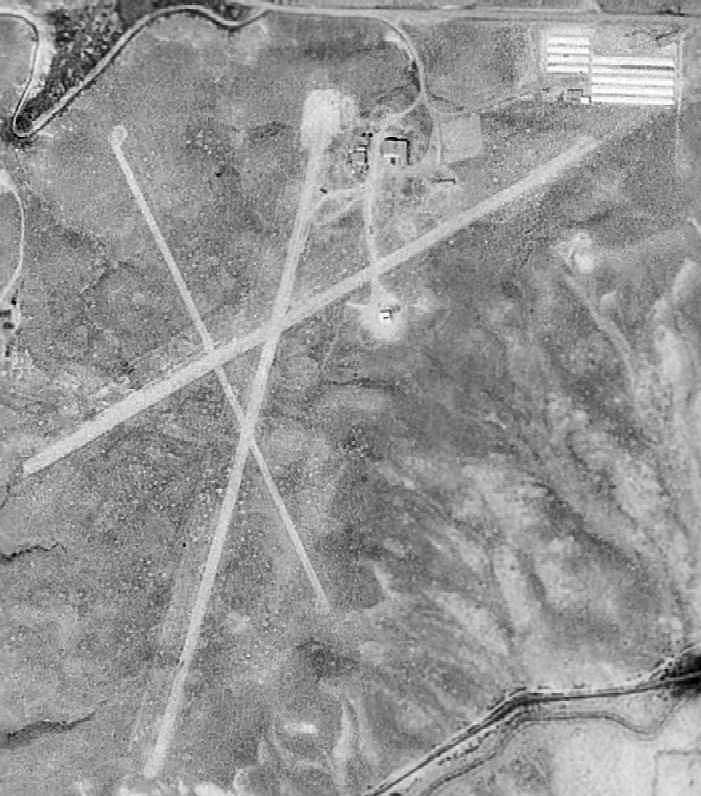
In the 1993 USGS aerial photo, the airport consisted of 3 runways (the longest was 3,000'),
as well as one small hangar & a few smaller structures at the northeast portion.
A row of sheds had been built along the northeast portion of what was previously the longest runway.
In August of 1994 this abandoned airport was evidently reopened, after going unused for at least 27 years,
as that is when the FAA Airport/Facility Directory listed as the activation date for the“Sky Island Ranch Airport”,
a private field at this location.
As of 2005, the field was said to be owned by Andrew Moffat, and to have 3 single-engine aircraft based on the field.
A 6/17/05 aerial view depicted 3 single-engine aircraft on the ramp.
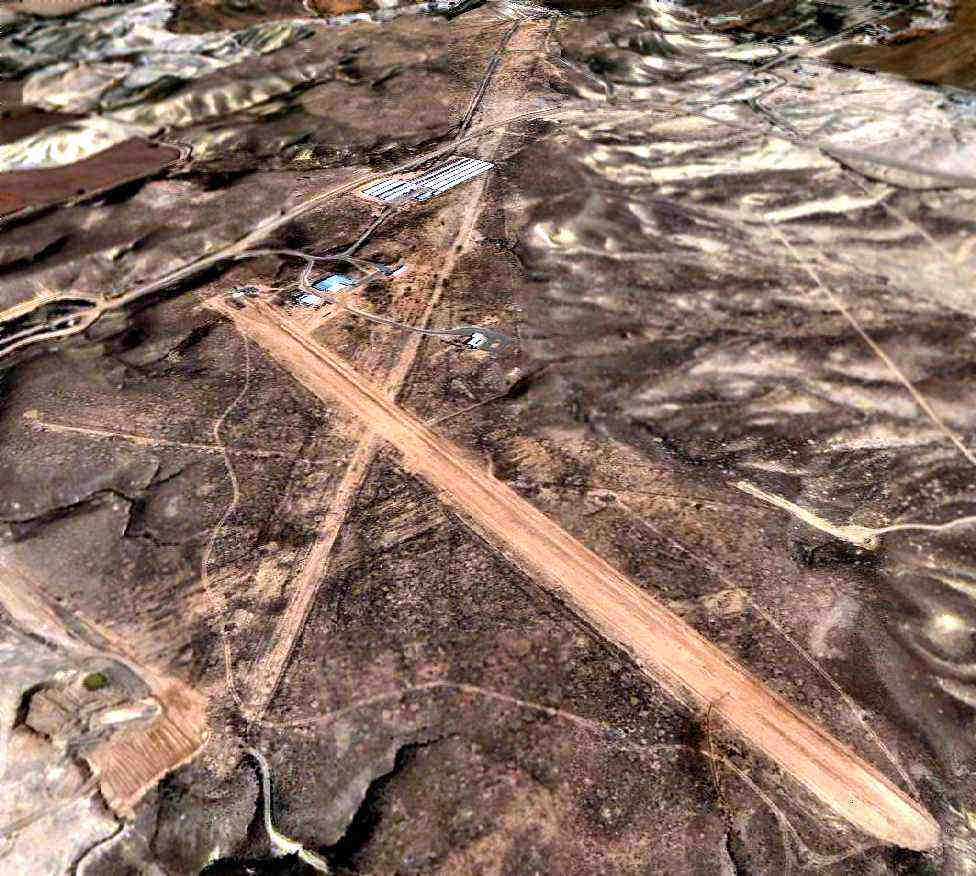
A 3/23/06 aerial view looking northeast at Sky Island Ranch Airport showed the north/south runway to appear to be the only runway remaining in use,
with the longest (northeast/southwest) runway crossed by a road & buildings, and the northwest/southeast runway barely still discernible.
Sky Island Ranch Airport is located along G Road, three miles east of Delta.
Thanks to Lonnie Woodard for pointing out this field.
____________________________________________________
Since this site was first put on the web in 1999, its popularity has grown tremendously.
If the total quantity of material on this site is to continue to grow,
it will require ever-increasing funding to pay its expenses.
Therefore, I request financial contributions from site visitors,
to help defray the increasing costs of the site
and ensure that it continues to be available & to grow.
What would you pay for a good aviation magazine, or a good aviation book?
Please consider a donation of an equivalent amount, at the least.
This site is not supported by commercial advertising –
it is purely supported by donations.
If you enjoy the site, and would like to make a financial contribution,
you
may use a credit card via
![]() :
:
Please consider checking the box to make a monthly donatation.
For a mailing address to send a check, please contact me at: paulandterryfreeman@gmail.com
If you enjoy this web site, please support it with a financial contribution.
please contact me at: paulandterryfreeman@gmail.com
If you enjoy this web site, please support it with a financial contribution.
____________________________________________________
This site covers airfields in all 50 states.